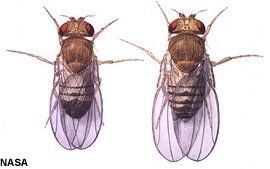Stuffing Fruit Flies to Aid Study on Human Obesity

Fruit flies that eat high-fat diets get fat, according to a new study. More important, fruit fly obesity looks much like human obesity, with symptoms including high cholesterol and blood sugar imbalances.
Researchers use fruit flies as model organisms for studying many medical and biological questions, but much obesity research has been done on mice. Doing similar research on fruit flies would be easier and cheaper, since their life spans are shorter and their care is less expensive.
But first, researchers have to be sure fruit flies are similar enough to humans for the results to be useful. In 2009, researchers pinpointed neurons in the flies' brains that sense and manipulate the insects' fat stores. The findings, reported in the journal Neuron, paralleled findings about the control of fat storage in mammalian brains.
Like last year's research, the new study finds parallels between flies and people. The results indicate that the disease of obesity goes way back, said study researcher Sean Oldham of the Sanford-Burnham Medical Research Institute in La Jolla, Calif.
"The capacity for this disease has been around for 500 million years," Oldham said in a statement.
Fattening up flies
To fatten up the fruit flies in their study, Oldham and his colleagues fed the insects a diet consisting of 30 percent fat in the form of coconut oil. Due to their hard exoskeletons, fruit flies can only gain so much, but the high-fat diet flies did put on weight.
Sign up for the Live Science daily newsletter now
Get the world’s most fascinating discoveries delivered straight to your inbox.
On top of their chubbiness, the flies showed the familiar signs of obesity in humans: high triglycerides (a form of fat found in the bloodstream, usually measured during cholesterol tests), disruptions in the balance between blood sugar and the fat-regulating hormone insulin, and even heart dysfunctions reminiscent of those found in diabetes.
"The fly hearts become less efficient," study co-author Rolf Bodmer, also of the Sanford-Burnham Institute, said in a statement.
The finding that fat-eating flies gain weight may seem obvious, but it's an important step in establishing a fruit fly model for obesity, the researchers wrote in the November issue of the journal Cell Metabolism. Testing obesity treatments on cheap, easy-to-raise model organisms like flies would be impossible if the insects didn't respond to fat the same way mammals do.
Teasing out obesity
The researchers aren't yet sure if the underlying causes for the flies' troubles are the same as those for obese humans. They did find that one line of cellular communication, a series of signals called the insulin/TOR pathway, is involved in fly obesity. Treatments that dampened the insulin/TOR pathway prevented the accumulation of excess fat in the flies and protected their hearts.
"When we manipulate this pathway in the hearts of flies, they are still obese, but their heart is 'blind' to the systemic effects," Bodmer said.
The researchers hope the finding could be an early clue for the treatment of human obesity. They also hope to use flies to sort out the complex genetic influences on obesity.
- 7 Diet Tricks That Really Work
- 8 Reasons Our Waistlines Are Expanding
- 7 Foods Your Heart Will Hate

Stephanie Pappas is a contributing writer for Live Science, covering topics ranging from geoscience to archaeology to the human brain and behavior. She was previously a senior writer for Live Science but is now a freelancer based in Denver, Colorado, and regularly contributes to Scientific American and The Monitor, the monthly magazine of the American Psychological Association. Stephanie received a bachelor's degree in psychology from the University of South Carolina and a graduate certificate in science communication from the University of California, Santa Cruz.









